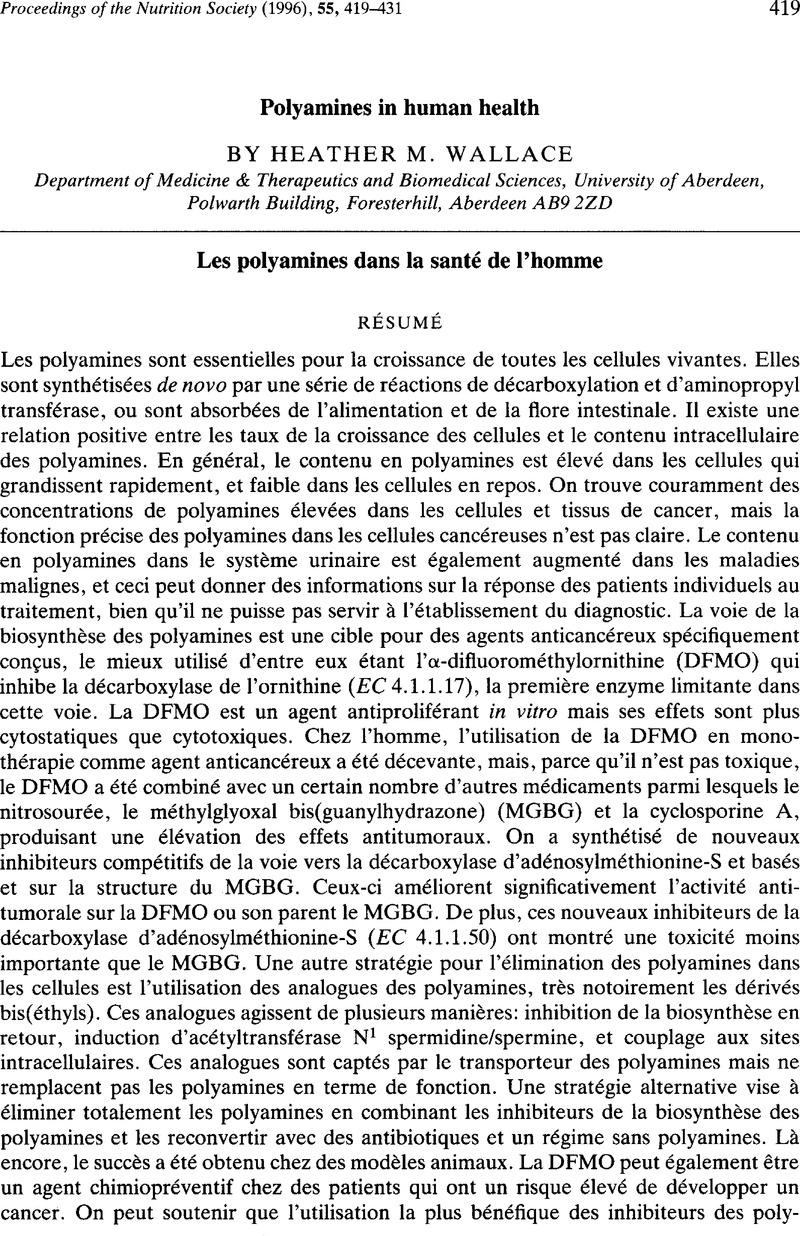Crossref Citations
This article has been cited by the following publications. This list is generated based on data provided by Crossref.
Zhao, Zhenjun
Baldo, Brian A
O’Brien, Richard M
and
Plomley, Richard F
2000.
Reaction with, and fine structural recognition of polyamines by human IgE antibodies.
Molecular Immunology,
Vol. 37,
Issue. 5,
p.
233.
Han, Xiaoli
Kazarinoff, Michael N.
Seiler, Nikolaus
and
Stanley, Bruce A.
2001.
Rat colon ornithine and arginine metabolism: coordinated effects after proliferative stimuli.
American Journal of Physiology-Gastrointestinal and Liver Physiology,
Vol. 280,
Issue. 3,
p.
G389.
Wallace, Heather M.
and
Caslake, Robert
2001.
Polyamines and colon cancer.
European Journal of Gastroenterology & Hepatology,
Vol. 13,
Issue. 9,
p.
1033.
Khuhawar, M.Y
and
Qureshi, G.A
2001.
Polyamines as cancer markers: applicable separation methods.
Journal of Chromatography B: Biomedical Sciences and Applications,
Vol. 764,
Issue. 1-2,
p.
385.
Liu, S. M.
Murray, A.
Schlink, A. C.
Mata, G.
and
Masters, D. G.
2002.
The effects of intradermal injections of spermidine on the growth rate of fibres and mitosis of wool follicles in Merino lambs.
Animal Science,
Vol. 75,
Issue. 1,
p.
33.
Reguera, Rosa María
Tekwani, Babu L.
and
Balaña-Fouce, Rafael
2005.
Polyamine transport in parasites: A potential target for new antiparasitic drug development.
Comparative Biochemistry and Physiology Part C: Toxicology & Pharmacology,
Vol. 140,
Issue. 2,
p.
151.
Wallace, H.M.
2007.
Health Implications of Dietary Amines: an overview of COST Action 922 (2001–2006).
Biochemical Society Transactions,
Vol. 35,
Issue. 2,
p.
293.
Basu, Indranil
Cordovano, Grace
Das, Ishita
Belbin, Thomas J.
Guha, Chandan
and
Schramm, Vern L.
2007.
A Transition State Analogue of 5′-Methylthioadenosine Phosphorylase Induces Apoptosis in Head and Neck Cancers.
Journal of Biological Chemistry,
Vol. 282,
Issue. 29,
p.
21477.
Hannestad, Ulf
Theodorsson, Elvar
and
Evengård, Birgitta
2007.
β-Alanine and γ-aminobutyric acid in chronic fatigue syndrome.
Clinica Chimica Acta,
Vol. 376,
Issue. 1-2,
p.
23.
Park, Jin-Young
Kim, Byung-Cheol
and
Park, Su-Moon
2007.
Molecular Recognition of Protonated Polyamines at Calix[4]Crown-5 Self-Assembled Monolayer Modified Electrodes by Impedance Measurements.
Analytical Chemistry,
Vol. 79,
Issue. 5,
p.
1890.
Deignan, Joshua L.
Livesay, Justin C.
Shantz, Lisa M.
Pegg, Anthony E.
O'Brien, William E.
Iyer, Ramaswamy K.
Cederbaum, Stephen D.
and
Grody, Wayne W.
2007.
Polyamine homeostasis in arginase knockout mice.
American Journal of Physiology-Cell Physiology,
Vol. 293,
Issue. 4,
p.
C1296.
Thompson, Patricia A.
Wertheim, Betsy C.
Zell, Jason A.
Chen, Wen-Pin
McLaren, Christine E.
LaFleur, Bonnie J.
Meyskens, Frank L.
and
Gerner, Eugene W.
2010.
Levels of Rectal Mucosal Polyamines and Prostaglandin E2 Predict Ability of DFMO and Sulindac to Prevent Colorectal Adenoma.
Gastroenterology,
Vol. 139,
Issue. 3,
p.
797.
Guan, Rong
Ho, Meng-Chiao
Brenowitz, Michael
Tyler, Peter C.
Evans, Gary B.
Almo, Steven C.
and
Schramm, Vern L.
2011.
Entropy-Driven Binding of Picomolar Transition State Analogue Inhibitors to Human 5′-Methylthioadenosine Phosphorylase.
Biochemistry,
Vol. 50,
Issue. 47,
p.
10408.
Hamdani, S.
Yaakoubi, H.
and
Carpentier, R.
2011.
Polyamines interaction with thylakoid proteins during stress.
Journal of Photochemistry and Photobiology B: Biology,
Vol. 104,
Issue. 1-2,
p.
314.
Raj, K P
Zell, J A
Rock, C L
McLaren, C E
Zoumas-Morse, C
Gerner, E W
and
Meyskens, F L
2013.
Role of dietary polyamines in a phase III clinical trial of difluoromethylornithine (DFMO) and sulindac for prevention of sporadic colorectal adenomas.
British Journal of Cancer,
Vol. 108,
Issue. 3,
p.
512.
Tran, Phu N.
and
Zell, Jason A.
2019.
Textbook of Gastrointestinal Oncology.
p.
509.
Niland, Courtney N.
Ghosh, Agnidipta
Cahill, Sean M.
and
Schramm, Vern L.
2021.
Mechanism and Inhibition of Human Methionine Adenosyltransferase 2A.
Biochemistry,
Vol. 60,
Issue. 10,
p.
791.



